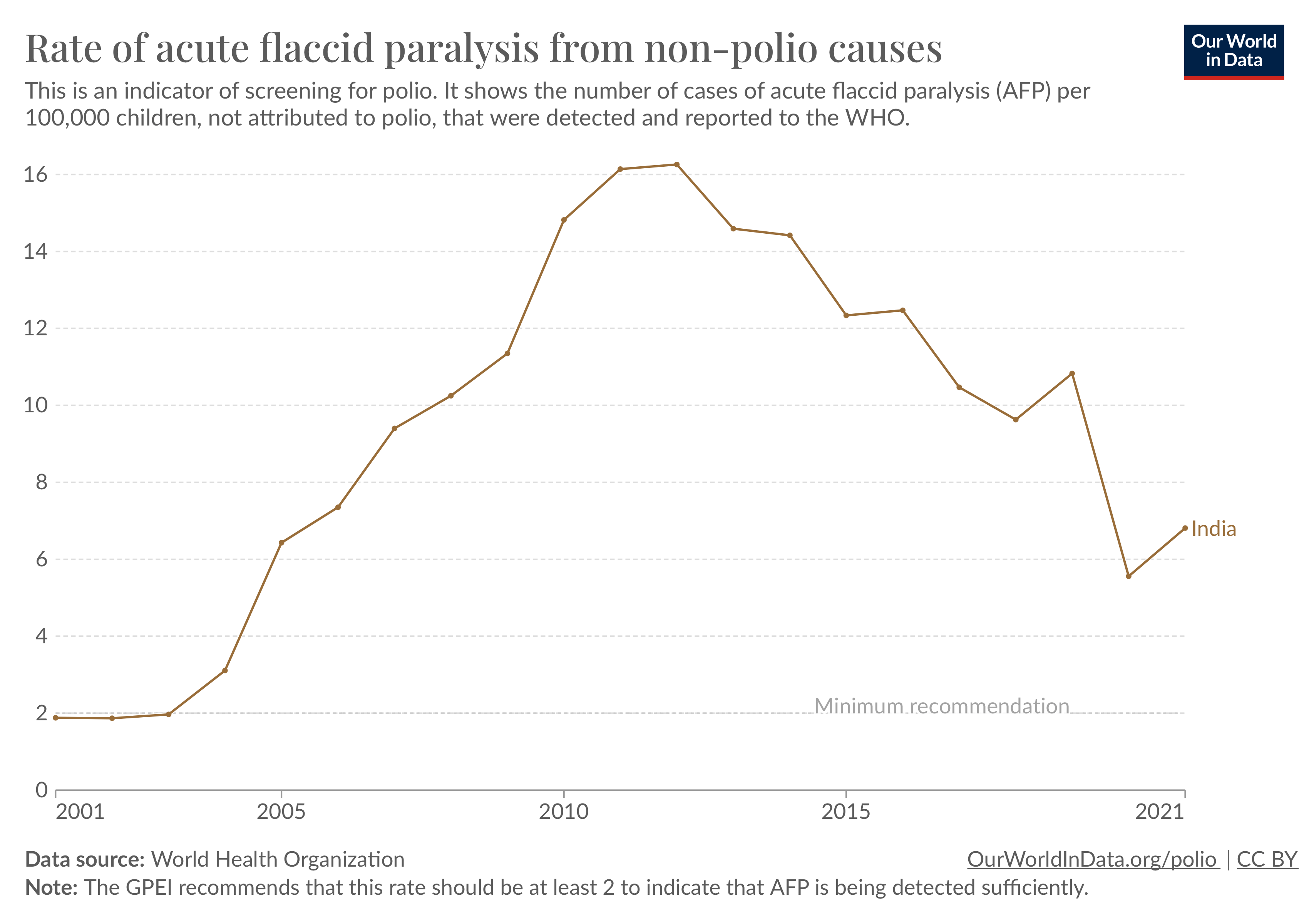
Factually inaccurate: The reel inaccurately suggested that there was a sudden “jump” in cases of non-polio AFP only after India was declared polio-free in 2014. In fact, epidemiological data showed a steady rise in cases of non-polio AFP that began in 2004. Cases peaked in 2012 and have since declined.

FULL CLAIM: “Polio is the number one ‘virus’ that people fall back on to defend vaccines. But sadly, it’s the biggest lie since Covid. Acute flaccid myelitis, Guillain Barré, all renames for polio. You can’t eradicate something if you keep renaming it.”; India had no non-polio paralysis cases before polio vaccination campaign, but this jumped to 60,000 cases after India was declared polio-free
REVIEW
An Instagram reel posted in January 2024 claimed that polio hasn’t actually been eradicated in India and that the disease was only being renamed as acute flaccid myelitis and Guillain Barré syndrome to hide its existence. It cited how cases of non-polio acute flaccid paralysis had increased from zero cases to 60,000 cases after polio was declared eradicated in India. Thus the reel was, in effect, claiming that the polio vaccine doesn’t work.
The reel was posted by the Instagram account you.dont.know.jac and received more than 15,000 views by the time of writing. The account, which has more than 83,000 followers, is run by an individual named Jaclyn Simone, who also claims vaccines cause encephalitis and autism (they don’t) and promotes an oil that allegedly detoxes and treats autism (there’s no evidence this works).
The claim that the polio vaccine doesn’t work and that polio has simply been renamed to hide its existence is an old one, as numerous articles, like this one by pediatrician Vincent Iannelli and another by virologist Ian Mackay, demonstrate. This claim is commonly used to downplay the public health achievements made possible by the polio vaccine. Readers may also recognize this tactic repurposed in the false but viral claim that the flu had simply been relabeled as COVID-19 to manufacture the semblance of a pandemic.
We explain below why the claims in the Instagram reel are inaccurate and aren’t substantiated by evidence.
Non-polio acute flaccid paralysis isn’t caused by polio, as its name indicates
Before the polio vaccine was introduced in India in 1978, the country saw an estimated 200,000 cases of polio annually. India’s polio eradication campaign, named the Pulse Polio Programme, was officially inaugurated in 1995. This vaccination campaign aimed to vaccinate all children under the age of five using the oral polio vaccine. At the time the campaign started, India saw around 50,000 polio cases every year.
In addition to the vaccination campaign, India conducted a polio surveillance program. This involved environmental surveillance of wastewater for poliovirus as well as the detection of cases of acute flaccid paralysis (AFP), the latter beginning in 1997. AFP is the main way in which polio manifests itself and is commonly seen in children under the age of 15. It is a neurological condition that results in weakness of limbs and often muscles involved in respiration and swallowing.
Polio doesn’t always cause paralysis—in fact, about 70% of infected children show no symptoms. However, infected people can shed virus from their nose, throat, and gut for days to weeks. This means that the virus can spread quickly in a population, especially one with low polio vaccine coverage.
Therefore, nationwide AFP surveillance is important for detecting polio cases early to curb its spread. Such surveillance is considered to be the gold standard for polio surveillance programs.
This involves finding cases of AFP and testing stool samples for the poliovirus. This testing is important because viruses other than polio can also cause AFP. In fact, the U.S. saw concerning outbreaks of AFP in November 2018, which were linked to enterovirus D68, a relative of the poliovirus.
AFP cases in which polio isn’t detected aren’t considered polio and are instead classified as non-polio AFP (NPAFP). The Global Polio Eradication Initiative states that countries should detect at least one annual case of NPAFP per 100,000 people aged less than 15 years to ensure that the surveillance program is sufficiently sensitive. This is because 1 in 100,000 is the known background rate of NPAFP.
The last case of polio in India was reported in 2011. After decades of concerted efforts at polio eradication, India was declared polio-free in 2014, after reporting zero cases of polio for three consecutive years.
The reel’s claim that India didn’t have any cases of NPAFP before the polio vaccination program started in 1995 is highly misleading, given that India didn’t have an AFP surveillance program at that time. The surveillance program only began in 1997, as explained earlier. Therefore, the country wouldn’t have had data on NPAFP to begin with.
Furthermore, NPAFP cases are, by definition, cases that aren’t caused by polio. AFP cases are investigated in order to rule out polio as a cause. Part of this investigation is testing patient samples for poliovirus. If poliovirus isn’t detected, then the case isn’t considered to be caused by polio.
While India continued to see tens of thousands of AFP cases after it was declared polio-free, none of these cases tested positive for polio, per the WHO’s Country Office for India:
“A total of 59,436 AFP cases were investigated in India in 2012, another 53,421 in 2013 and 53,383 in 2014. Not a single AFP case has tested positive for polio in 2012, 2013 and 2014. All AFP cases during the last 3 years have been due to non-polio causes.”
Therefore, the reel’s claim that polio cases have simply been relabeled as NPAFP is inaccurate and demonstrates a lack of understanding of how NPAFP cases are identified.
Nor is polio being renamed as acute flaccid myelitis or Guillain-Barré syndrome. Cases of suspected acute flaccid myelitis undergo laboratory testing in order to determine the cause of the disease. This includes testing patient samples to identify viruses. If polio is detected, the case is considered polio, not acute flaccid myelitis.
Guillain-Barré syndrome is another neurological condition that produces weakness and sometimes paralysis, but isn’t associated with poliovirus. Instead, it is associated with infection by the bacterium Campylobacter jejuni, the flu virus, cytomegalovirus, and Epstein-Barr virus.
Rise in AFP cases in India already began in 2004 and coincided with increased efforts to detect polio cases, involving broadened AFP definition
The epidemiological data from India does show that NPAFP cases were particularly high after India was declared to be polio-free in 2014 (Figure 1).

Figure 1 – The rate of NPAFP in India per 100,000 children between 2001 and 2021. Source: Our World in Data. Data retrieved on 30 January 2024.
But as the graph above also shows, the rise in NPAFP had already begun sometime in 2005, nearly a decade before India was declared polio-free, and continued to rise after 2005. And while it did peak in 2012, it has since fallen.
Both observations speak against the claim that NPAFP is simply a new label for polio after the disease was declared eradicated. If the claim were true, then we would have expected the number of NPAFP cases to continue to climb after 2014, but cases have fallen instead.
It is worth noting that it was also between 2004 and 2005 that India stepped up its efforts to detect polio cases[1]. To that end, the definition of AFP was broadened to include even transient weakness and facial paralysis. Moreover, to further enhance the sensitivity of the program, the number of AFP case-reporting sites in the country rose from 21,403 in 2004 to 36,629 in 2012 to include health facilities serving migrant and high-risk populations.
This combination of changes to the AFP surveillance program likely contributed, at least in part, to the rise in the number of NPAFP cases detected.
Virologist Ian Mackay, who works at the Infectious Diseases Laboratory, Pathology Queensland, highlighted how polio hasn’t been detected in India, despite the tens of thousands of AFP cases every year, underscoring the specificity of the polio vaccine’s effect:
“Ironically the fact that India still has tens of thousands of NPAFP cases each year – and not a single polio case among them – highlights that the polio vaccine is what made the real difference. Vaccines work. And polio is almost eradicated because of their effectiveness.”
Conclusion
The reel’s claim that the polio vaccine doesn’t work hinges on cherry-picking epidemiological data and a conspiracy theory that polio has simply been renamed acute flaccid myelitis and Guillain-Barré syndrome to hide its existence. However, this is inconsistent with what we know of polio surveillance programs. A critical part of such programs is laboratory testing to identify the cause of AFP cases. NPAFP cases are, by definition, cases in which polio wasn’t detected and therefore aren’t considered polio cases. Acute flaccid myelitis is also, by definition, not caused by polio, and therefore aren’t polio cases. And Guillain-Barré syndrome isn’t associated with poliovirus.
The reel also claimed that there was a sudden rise in these cases only after India was declared polio-free, but this is also inaccurate. While NPAFP cases were quite high in 2014, which is when India achieved its polio-free status, NPAFP cases had already begun to rise between 2004 and 2005, which also coincides with increased efforts to detect polio cases in India. Part of this included using a broader definition of AFP to include even transient cases, which likely contributed to the rise, since such cases wouldn’t have been included in the past based on the earlier, narrower definition.
REFERENCES
- 1 – Cardemil et al. (2013) Surveillance during an era of rapidly changing poliovirus epidemiology in India: the role of one vs. two stool specimens in poliovirus detection, 2000–2010. Epidemiology and Infection.


